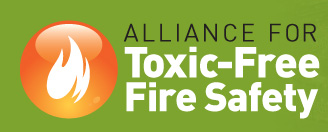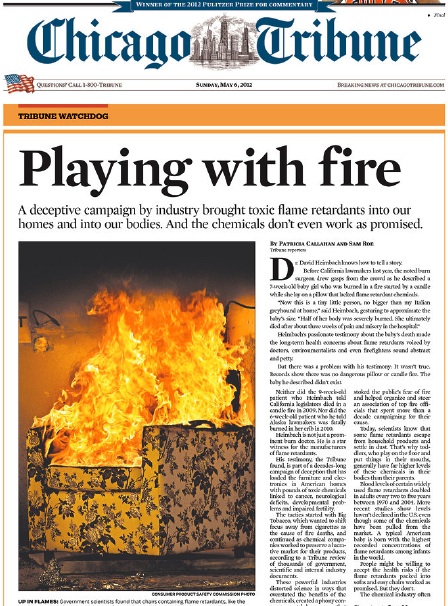  |
|||
Contact: Stephenie Hendricks, stephdh@earthlink.net, 415-258-9151 May 8, 2012
Chemical Industry Front Group Exposed; Deceitful Tactics Promote Toxic Flame Retardant Chemicals State Legislatures Targeted, Fall Victim
(San Francisco) The Chicago Tribune reported Sunday that corporations making flame retardants have spent millions of dollars on front groups, “pay for play” experts, and lobbying in order to defeat new restrictions on their hazardous chemicals, even when those laws were actively supported by fire fighters, scientists, and licensed public health professionals alike. The deceptive tactics of Albermarle, Chemtura, and Israel Chemicals Ltd are the reason that all furniture and baby products sold in California and across much of the US contain toxic and ineffective flame retardants. New York State passed a ban on TCEP flame retardant in 2011 and more recently the New York State Assembly unanimously passed a bill to ban the flame retardant TDCPP. That bill is now headed to the Environmental Conservation Committee in the Senate. “The industry shenanigans that the Tribune exposed have also been on display in New York,” said Bobbi Chase Wilding, Deputy Director with Clean and Healthy New York, which supports policy action on flame retardants. “The Chicago Tribune series should be required reading for the NYS Senate as they consider expanding a ban on these chemicals.” The Tribune investigation detailed the exploits of chemical industry front group, “Citizens for Fire Safety,” which purports to be a grass roots community group. “I am glad to see ‘Citizens for Fire Safety’ exposed as the ugly sham they truly are,” said Senator Sharon Nelson, Chair of the Senate Environment Committee in Washington state and sponsor of the Toxic Free Kids Act. “I am hopeful this will help raise awareness for real citizens about the dangers of these chemicals and help us get off the toxic treadmill once and for all.” “It’s hard to believe that we have levels of flame retardant chemicals- measured in pounds - similar to banned pesticides like DDT in our furniture that end up in our bodies, our pets, and wildlife. The only benefits are to the bottom line profits of the chemical producers,” said Arlene Blum, a chemist at UC Berkeley and Executive Director of the Green Science Policy Institute. “This article should help stop new flammability standards, currently being promoted by the industry, that are designed to sell chemicals rather than to increase fire safety.” Scientific research has linked exposure to retardant chemicals to lowered IQ, learning disabilities, infertility, other reproductive problems, and endocrine system irregularities. Because of industry supported flammability standards, retardant chemicals are added to many electronics, plastics, and polyurethane foam-containing goods like furniture, car seats, and crib liners. They escape from these products and build up in dust where people are exposed. Toddlers, who spend more time on the ground and have more hand to mouth behavior, have higher levels of retardant chemicals in their blood than adults. Among the global populations, babies born in America have the highest levels of these chemicals in their blood. "The chemical industry’s stranglehold over public policy must end,” said Pamela Miller, Executive Director with Alaska Community Action on Toxics, a group that supports policy to restrict retardant chemicals. On April 2, the Alaska State Senate passed legislation that would ban the use of polybrominated fire retardants (PBDEs) in mattresses, upholstered furniture and electronics. Dr. David Heimbach, the notorious witness whose fraudulent testimony was exposed by the Tribune’s Sunday expose, testified alongside another Citizens for Fire Safety representative. The bill was then sent to the Alaska House Labor and Commerce Committee where it languished when the legislature adjourned. “It is vital that we prevent the use of these toxic flame retardants at state and international levels because they are contaminating the global environment and harming public health,” said Miller. “They are widespread in the Arctic environment and found at high levels in the breast milk and blood of Arctic Indigenous women.” "Perhaps most disturbing to me, is the industry's use of people of color organizations to fight restrictions on flame retardant chemicals," said Mark Mitchell M.D., MPH, Co-Chair of the Environmental Health Task Force of the National Medical Association. The National Medical Association is the largest and oldest national organization representing African American physicians and their patients in the United States. "The science is abundantly clear that these chemicals are linked to health disorders that are of serious concern to ethnic communities and that these same communities are disproportionately exposed to flame retardant chemicals," said Dr. Mitchell. "It seems only a pattern of deceit and deception on the part of the chemical companies would lead people of color organizations to support their agenda." "The agenda of the chemical industry may be to protect profits over all else, but I am a nurse,” says Katie Huffling, RN, MS, CNM, from the Alliance of Nurses for Healthy Environments. “My priority is public health. And I can tell you children are not being protected from toxic chemicals. Otherwise, we wouldn't have burgeoning rates of childhood cancer, learning disabilities, juvenile diabetes, and other health problems.” “The flame retardant industry is so desperate to hold onto their profits from cancer-causing flame retardants that they use scare tactics and spend millions to keep peddling their poisons,"says Laurie Valeriano, Executive Director of the Washington Toxics Coalition, a group that worked to pass the first statewide ban on decaDE and supported a statewide ban on toxic tris flame retardants (TDCPP and TCEP) this year."In Washington State it was shocking that other companies like Johnson & Johnson, the Toy Industry Association, Wal-Mart, Target, and the Personal Care Products Council, teamed up with the chemical industry to do their bidding to oppose limits on these flame retardants in children's products.” "Manufacturers and retailers don't want toxic chemicals in their products," explains David Levine, CEO of the American Sustainable Business Council. "It’s just good business sense to understand that companies want certainty that their goods are safe for their workers and customers. A few big corporations fighting modern chemical regulations are hurting all businesses, especially small businesses.” Rather than attacking the source of fires, principally smoldering cigarettes, the chemical industry vehemently opposed self-extinguishing cigarettes, so-called “fire safe cigarettes”, and instead lobbied for regulations like California Technical Bulletin 117 that virtually mandates that retardant chemicals be added to thousands of consumer goods, like baby changing pads, car seats, furniture, insulation, and crib liners. Federal studies have shown that use of flame retardants doesn’t prevent fires and smoke from burning products treated with flame retardants is much more toxic than smoke from untreated materials, signaling a significant threat to building occupants trying to escape fires and to fire fighters. “A functioning federal regulatory program would have weeded out halogenated flame retardants long ago,” said Kathy Curtis, LPN, Coordinator of the Alliance for Toxic-Free Fire Safety. “Instead, these poisons were considered safe without evidence. Despite the deceitful positions by the chemical industry, a dozen states have taken action to ban them, but the replacement alternatives are just as bad for families. Without new policy defining what is acceptable, there is apparently no incentive for these chemical corporations to invest in safer alternatives. Instead, they are doubling down to prevent the Safe Chemicals Act from modernizing federal standards while the vast majority of Americans, regardless of political affiliation, support better regulations.” “The same chemical companies fighting US policies have tried to oppose international restrictions on their toxic products,” said Joseph DiGangi, PhD, Senior Scientist and Technical Advisor with IPEN. “Despite their efforts, more than 170 countries agreed to ban three commercial flame retardant mixtures in addition to PCBs through the Stockholm Convention on Persistent Organic Pollutants.” For more info: www.toxicfreefiresafety.org
|
|||





